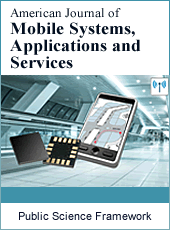American Journal of Mobile Systems, Applications and Services
Articles Information
American Journal of Mobile Systems, Applications and Services, Vol.1, No.3, Dec. 2015, Pub. Date: Nov. 12, 2015
Liveness Detection for Fingerprint Biometrics
Pages: 190-195 Views: 2688 Downloads: 1400
[01]
Arunalatha G., Department of Computer Science and Engineering, Pondicherry Engineering College, Puducherry, India.
[02]
M. Ezhilarasan, Department of Information Technology, Pondicherry Engineering College, Puducherry, India.
Biometrics refers to automated recognition of individuals based on their biological and behavioral characteristics. Biometric systems are widely used for security. They are used in forensic and commercial applications. Among all biometric techniques, fingerprint recognition is the most widely used for personal identification systems due to its permanence and uniqueness. But biometric systems are vulnerable to certain type of attacks. Spoofing refers to the fraudulent action by an unauthorized person into biometric systems using fake input that reproduces one of the authorized person’s biometric input. Liveness detection provides extra level of authentication to biometrics. It is used to prevent forgeries. The fingerprint Liveness detection is performed by measuring the following quality features of fingerprint. They are Spatial Coherence, Gabor Features, Ridge frequency. This approach is based on fingerprint image quality. This technique is software based as it requires no external hardware. This approach is inexpensive.
Fingerprint, Liveness, Fake, Real, Spoof
[01]
U. Uludag and Anil K. Jain, Attacks on biometric systems: A case study in fingerprints, Proc. SPIE, 5306: 622–633 (2004).
[02]
Javier Galbally, Fernando Alonso-Fernandez, Julian Fierrez and Javier Ortega-Garcia, A high performance fingerprint liveness detection method based on quality, Future Generation Computer Systems, 28: 311–321 (2012).
[03]
Ankita Chaudhari and P. J. Deore, Spoof attack detection in fingerprint biometric system using histogram features, Proc. World Journal of Science and Technology, 2(4): 108–111 (2012).
[04]
Ahmad A. Hassan and Ahmad M. Bhram, Enhancing the Security of Biometric Systems on View of BioFM, Proc. ICCIT (2012).
[05]
Galbally Javier, Raffaele Cappelli, Alessandra Lumini, Guillermo Gonzalez-de-Rivera Davide Maltoni, Julian Fierrez, Javier Ortega-Garcia and Dario Maio, An evaluation of direct attacks using fake fingers generated from ISO templates, Pattern Recognition Letters, 31: 725–732 (2010).
[06]
Aditya Abhyankara and Stephanie Schuckersa, A wavelet based approach to detecting liveness in fingerprint scanners, SPIE Proceedings, 5404: 278–286 (2004).
[07]
Heeseung Choi, Raechoong Kang, Kyoungtaek Choi, Andrew, Teoh Beng Jin and Jaihie Kim, Fake-fingerprint detection using multiple static features, Proc. Optical Engineering (2009).
[08]
Aditya Abhyankar and Stephanie Schuckers, Integrating a wavelet based perspiration liveness check with fingerprint recognition, Pattern Recognition, 42: 452–464 (2009).
[09]
B. Tan and S. Schuckers, Spoofing Protection for Fingerprint Scanner by Fusing Ridge Signal and Valley Noise, Pattern Recognition, 4(8): 2845–2857 (2010).
[10]
S. Tan and S. Schuckers, A New Approach for Liveness Detection in Fingerprint Scanners Based on Valley Noise Analysis, Journal of Electronic Imaging, 17(1): 011009-1 to 011009-9 (2008).
[11]
A. Jain, Y. Chen and S. Dass, Fingerprint deformation for spoof detection. Biometric Symposium, (2005).
[12]
K. C. Chan, K. So, Y. S. Moon, J. S. Chen and K. So Woo, Wavelet based fingerprint liveness detection. Electronic Letters, 41(20): 1112–1113 (2005).
[13]
Y. Chen, S. Dass and A. Jain, Fingerprint quality indices for predicting authentication performance, in Proc. AVBPA: 160–170 (2005).
[14]
L. Shen, A. Kot and W. Koo, Quality measures of fingerprint images, in Proc. Audio Video-Based Person Authentication: 266–271 (2001).
[15]
E. Lim, X. Jiang and W. Yau, Fingerprint quality and validity analysis, in Proc. Int. Conf. Image Process, 469–472 (2002).
[16]
C. Watson, M. Garris, E. Tabassi, C Wilson, R. McCabe, and S. Janet, User’s Guide to Fingerprint Image Software 2-NFIS2 [Online]. Available: http:www//fingerprint.nist.gov/NFIS. NIST, (2004).

ISSN Print: 2471-7282
ISSN Online: 2471-7290
Current Issue:
Vol. 5, Issue 1, March Submit a Manuscript Join Editorial Board Join Reviewer Team
ISSN Online: 2471-7290
Current Issue:
Vol. 5, Issue 1, March Submit a Manuscript Join Editorial Board Join Reviewer Team
| About This Journal |
| All Issues |
| Open Access |
| Indexing |
| Payment Information |
| Author Guidelines |
| Review Process |
| Publication Ethics |
| Editorial Board |
| Peer Reviewers |


